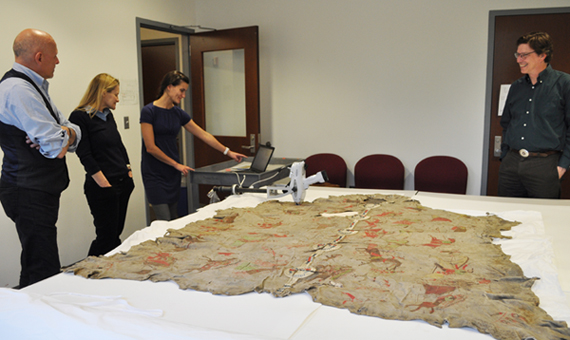
The Conservation Department now has a portable x-ray fluorescence analyzer (or pXRF) courtesy of the 1956 Otto Haas Charitable Trust. This is great news for the lab, since now we can answer frequently asked questions without having to consider destructive testing. As stewards of our world’s material culture, this is a great new advantage!
XRF is a means of using x-rays to identify the elements in our collections. The technique is great for helping us identify pigments, metal alloy components, glaze and glass colorants, some pesticides, and more. The Lakota Buffalo Robe in our American Section (detail in image above and during examination below) offers an interesting example of pigment identification. Using XRF, we found mercury in the red, copper in the green, and a mixture of barium, chromium and lead in the yellow. With this information, we already have a pretty good idea of how and when this robe was painted. The mercury indicates vermilion as the red pigment. The green is a copper-based pigment such as malachite. The yellow is barium yellow, chrome yellow or a mixture of the two. If it is not a mixture, the pigment most likely has an extender added.

Knowing that the yellow is either barium or chrome yellow also tells us that the robe was probably made in the nineteenth century. This is consistent with date attributions based on stylistic analysis by William Wierzbowski from the American section, who dates the robe to the first half of the nineteenth century. Both yellow possibilities were first discovered in the early 1800’s. This tells us that the robe was painted at some point after that. Later in the nineteenth century, these yellows gave way to others, so it is likely that they would not have been chosen if the robe were made in the twentieth century. This supports Wierzbowski’s conclusions that could not otherwise be confirmed since the museum does not have known collection data for this robe. Because barium yellow was not commercially in use until closer to the 1830’s, finding out exactly which yellow we have could help us narrow our time frame even further.
While XRF cannot give us structural information, it has answered most of our questions, and focused the remaining question down to a very specific detail. Now we can make an informed decision as to whether or not we need to answer that question too. XRF technology has been around for some time; it was already being applied to art by 1958 when it is first mentioned in the conservation literature. It is only recently, however, that the technique was refined enough to make it portable and increasingly affordable. We are thrilled to now have our very own analyzer at the Museum!
Watch this video to hear more about how XRF works and to see other examples of how it is being applied to the Penn Museum collection:
